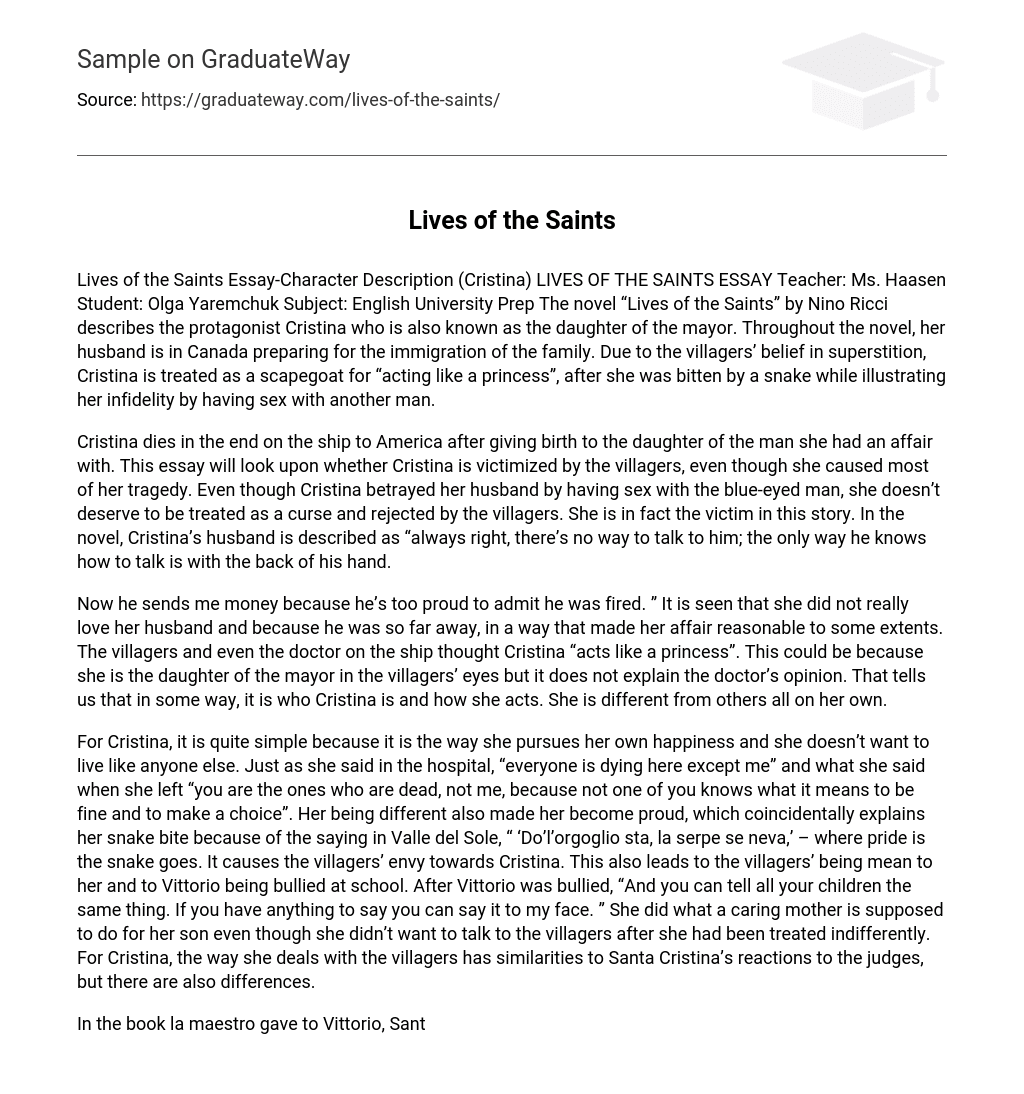The novel “Lives of the Saints” by Nino Ricci features Cristina as its protagonist, also known as the mayor’s daughter. Throughout the story, her husband is in Canada preparing for their family’s immigration. However, due to the superstitious beliefs of the villagers, Cristina becomes a scapegoat for “acting like a princess” after being bitten by a snake while engaging in infidelity with another man. Ultimately, Cristina dies on the ship to America after giving birth to her affair partner’s daughter. This essay aims to explore whether Cristina is victimized by the villagers despite contributing to her own downfall. Despite betraying her husband and having an affair, it is unjustifiable for the villagers to treat Cristina as a curse or reject her. In reality, she is the true victim of this story. The novel portrays Cristina’s husband as an authoritarian figure who believes he is always right and resorts to physical violence for communication.
Despite her husband’s termination, he still provides financial support to his wife due to his pride. It is evident that her feelings towards her husband were not genuine, and their physical separation somewhat justified her infidelity. Both the villagers and the ship’s doctor view Cristina as someone who exhibits princess-like behavior. While the villagers may attribute this to her being the mayor’s daughter, it does not account for the doctor’s perception. This suggests that Cristina’s distinct demeanor and conduct distinguish her from others.
Cristina pursues her own happiness and refuses to conform to societal expectations. In the hospital, she emphasized that she was the only one not dying, while upon leaving she declared that the others were the ones truly dead because they didn’t understand the meaning of being content and making choices. Her uniqueness led to her pride, which is reflected in the saying in Valle del Sole: ” ‘Do’l’orgoglio sta, la serpe se neva,’ – where pride is, the snake goes.” This pride also caused envy among the villagers, resulting in their cruel treatment of Cristina and bullying of her son, Vittorio, at school. Despite facing indifference from the villagers, Cristina stood up for her son and refused to back down. While she had similarities to Santa Cristina in how she dealt with the judges, there were also differences in their approaches.
In the book, the maestro bestowed upon Vittorio a book about Santa Cristina, who came from a respectable family and was accused by her own father. Nevertheless, she stayed unwavering in her faith and refused to surrender. Similarly, Cristina insists on leading life according to her own principles and disregards the villagers’ apathy. Just like Santa Cristina, she dismisses her friend’s suggestion of making a gesture since superstition holds no sway over her beliefs. However, unlike Santa Cristina who endured torture and execution at the hands of judges, Cristina simply turns away from the villagers and forges her own path.
She only spoke when Vittorio was being bullied and right before they left the village. It was at that moment when she expressed her feelings about how the villagers treated her. According to the text, “The villagers avoided anyone or anything that had been touched by the eye, as if there was a risk of spreading the affliction.” Even Cristina’s own father doesn’t talk to her and “the house remained quiet, with my mother knitting silently in a corner of the kitchen.” Cristina is facing difficulties, but she handles it in a more suitable and less harsh manner, which aligns with modern society.
As the story progresses, Mario becomes aware of Cristina’s affair. The arrival of frequent letters for Cristina implies that her husband is pressuring her. One letter asks Cristina to take Vittorio to America, indicating her husband’s demands. Another letter arrives with a different handwriting, likely from the blue-eyed man mentioned earlier. In this neat bright blue script, he asks Cristina to meet him in America. To prepare for this journey, Cristina decides to go to Rome and arrange passports and visas. During the voyage, she gives birth during a storm. Ultimately, the story concludes with Cristina’s death mirroring Santa Cristina’s demise. Similar to many individuals in today’s society, Cristina lives life on her own terms and seeks happiness despite being considered a scapegoat during that time period. From a modern perspective, it is unfair for her to be treated this way; thus, her death is truly tragic.





